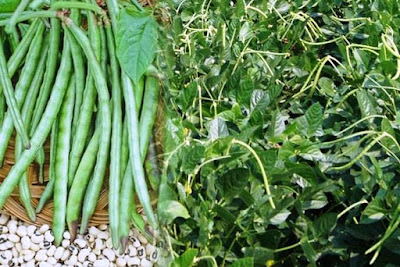Cowpea
Origin-
Originated in Africa and widely grown in Africa.
Geographical Distribution-
Major cowpea growing countries are- Nigeria, Bangladesh, Indonesia, Thailand.
Climate-
- It needs warm weather and semi-arid crop where temperature ranging from 20oC-30oC.
- It can grow under shade of tree but cannot tolerate cold or frost.
Soil-
- Well drained loam or slightly heavy soil are best suited.
- It can grow in acid soil but cannot in alkaline(basic) soil.
Varieties-
Grain- C-152, Pusa Phalguni, Amba(V-16).
Fodder- GFC-1, GFC-2, GFC-3, GFC-4,etc.
Fodder- GFC-1, GFC-2, GFC-3, GFC-4,etc.
Sowing of Seed-
- Time of sowing is depend on variety.
- Kharif Crop- With starting of monsoon ranging from early June-end of July.
- Rabi crop- November (Southern India)
- Summer:2nd-4th week of March(grain), February(fodder).
- Hills: April-May.
Seed Rate-
- Pure Crop:20-25 kg/ha(grain)
- Fodder and Green Manuring:30-35 kg/ha.
- In Summer, 30 kg/ha for grain and 4 kg/ha for fodder.
Spacing-
- Row to row 30 cm bushing to 45 cm spreading.
- Plant to Plant 10 cm Bushing to 15 cm spreading.
Method of Sowing-
- Broadcasting, Line sowing and dibbling of seeds based on their purpose and season.
- Sowing of seed at a depth of 3-5 cm.
- In high rainfall area, formed 30 cm wide and 15 cm deep drainage channel at every 2 m interval to drain excess rain water.
Seed Treatment-
- Treat the seed with Thirum 2g + carbendazim 1g.
- It is also good for seeds to treat with Rhizobium culture 10g/kg seed.
Manuring-
- Apply FYM/compost 5-10t/ha as basal with last ploughing.
- Nitrogen(N)15-20 kg/ha as starter dose in poor soils.
- 50-60 kg/ha P2O5 and 50-60 kg/ha K2O.
Intercultural Operation(Weeding)-
- For higher yield crop should be free from weed upto 25-30 days crop stage.
- Pendimethalin 0.75-1 kg/ha combined with one hand weeding at 35 days after sowing.
Irrigation-
5-6 irrigation depending on soil type.
Harvesting-
- Green pods for vegetable use harvested at 45-90 days.
- For grain, crop can be harvested in about 90-125 days after sowing when pods are fully matured.
- For Fodder, the cutting of the crop depends upon the need and the stage of growth of the crop.
Yield-
Good crop of cowpea yield about 12-15q/ha and 50-60q/ha of straw.
250-350q/ha of green fodder.
250-350q/ha of green fodder.
Cluster Bean
Origin-
- Cluster bean origin was unknown.
- It is assumed that cluster bean developed from the African species.
Soil-
Cluster bean can grow in all type f soil but sandy loam soils are better for its growth.
Climate-
It requires warm growing season.
Varieties-
Bundle Guar-1, Bundle Guar-2, Bundle Guar-3, HG-182, etc.
Sowing-
- Kharif season follow rain.
- Summer crop sowing is done in February to march.
Method of sowing-
Seeds are either broadcasted or dipped behind a country plough at a distance of 25-30 cm.
Spacing-
Average, 45-60*25-30 cm is required for planting of cluster bean.
In rainy season seeds are planted on ridges while in summer, furrow method is followed.
In rainy season seeds are planted on ridges while in summer, furrow method is followed.
Application of fertilizers-
DAP-50 kg and 10 kg Zinc Sulphate/acre.
Weeding-
Application of atrazine 1lt/acre is suitable for weed free cluster field.
Irrigation-
2-3 irrigations for heavy soil and 4-5 irrigation for light soils are necessary for proper growth of the crop.
Harvesting-
For vegetable purpose, harvesting starts after 40 days of sowing and pods are plucked at tender stage.
Yield-
- Vegetable yield:6-8t/ha
- Seed yield: 0.6-1.2t/ha are expected within the crop duration of 120 days.
Napier Grass
Origin-
It is said that napier grass is native to Africa where it is grown as forage plant.
Geographical Distribution-
This grass is widely grown in the tropical and subtropical regions of the world.
Economic Importance-
- Elephant grass(Napier Grass) generally used as fodder crop.
- It provides huge amount of protein to the cattles.
- Elephant grass also used for increasing soil fertility and also used for controlling soil erosion.
Varieties-
CO 3, PBN 233, CO 4,etc.
Soil-
- Light loamy and sandy soils are the most appropriate soils for napier grass.
- The pH value for napier grown is between 5.0-8.0
Climate-
- Napier grass are good at temperature between 26OC-42OC.
- Cropping of napier is done in any season if irrigation facility is good.
- Monsoon season is good for napier.
- Preparation of land-
- The field was harrowed and ploughed very well before cultivation of the grass.
Sowing-
In India it was sown in the last week of February to the last week of August.
Plantation-
Their are two common method for plantation are-
- Conventional Method.
- Tumbukiza Method.
- You have to dig the field at least 20 cm in width and depth.
- Plant to Plant distance is 90cms.
- Row to Row distance is 60cms.
Tumbukiza Method-
It is done in two ways-
- Round Pit.
- Rectangular Pit.
- In Tumbukiza method 60 cm is depth and 60-90 cm is width.
- The pit size depend on land.
- The spacing between pit is 90 cm.
Harvesting-
Napier grass is generally harvested the height of 120 cm and harvesting take place at 180-240 days after planting.
Storage-
Napier grass is conserved or stored in silage.
Yield-
For Cereals-Wheat, Rice, Sorghum, Pearl Millet.
For Pulses(Pigeon Pea, Mung Bean, Urd Bean)-



Comments